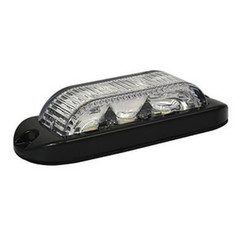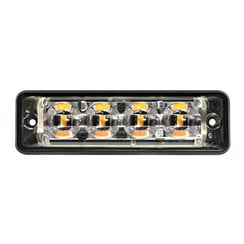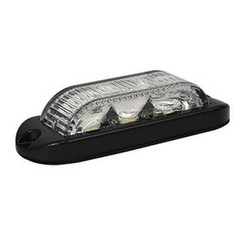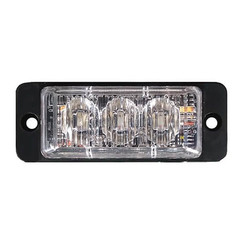You have no items in your shopping cart
LED Signalling for vans
There are various types of signalling that are suitable for a van. Signals are intended to be highly visible. Signals let people know that they are approaching a special situation. TRALERT® has a wide range of signalling devices, such as beacons, directional warning lights and light bars.
Different types of signalling for a van
There are different types of signalling available for a van. Each type of signalling has its own advantages and is intended for a specific situation. You cannot just use any form of signalling everywhere. The colour of the signalling also entails rules. The signalling is easy to mount on your vehicle; there are various options for this, from screw mounting to the use of a magnet.
Beacons as a signalling system for your van
The first option you have when it comes to signalling for a van is the use of beacons. You have undoubtedly come across beacons at some point. They are used a lot on and around the road. If you want to use beacons in traffic, you have to comply with various rules. Blue, red and green are not allowed on the Dutch public roads at all. The orange (amber) colour may be used in certain situations.
The advantage of LED beacons compared to, for example, halogen beacons is that LED lasts much longer. In addition, it also consumes a lot less energy. There are also no rotating parts in the LED beacons, which means that the parts cannot wear out. With LED beacons, it is also possible to emit different light patterns. Click here for our entire range of LED beacons.

LED light bars as a sign for your van
Flashing light bars are another form of signalling for your van. This type of signalling is intended to be mounted on the roof of your vehicle. Just like beacons, light bars are meant to show bystanders that a special situation is about to occur. In addition, it is also for the safety of the driver. The light bars make the driver more visible, which reduces the risk of accidents. Check out our entire range of LED light bars here.

LED directional warning lights as signalling for your van
LED directional warning lights are also meant to make you more visible in traffic. The directional warning lights are very easy to install in the grill of your van. The directional warning lights also contribute enormously to traffic safety. When your van stands out in a special situation, other road users will be able to react sooner. As a result, fewer accidents will occur. Click for our entire range of LED directional warning lights.

Coloured signalling
Within the TRALERT® product range you will find different coloured signs. Orange, also called amber, is the most common colour when it comes to lighting in traffic. Besides amber there are other colours available, but not all of them can be used in every situation.

Red signalling
Red signs are not meant for public roads. The red colour can mislead road users as red lights are normally only found at the rear of a vehicle. When road users drive with red signalling lights, it is difficult to estimate in which direction the vehicle is going. In addition, there are several countries where the red signal is used for the emergency services.
Blue signalling
Blue signalling is used in the Netherlands by the emergency services. Only vehicles belonging to the police, fire brigade and ambulance services, for instance, may use blue signs on public roads. This is done so that it is clear to everyone in traffic what kind of vehicle is approaching. The blue signal also shows that the vehicle has right of way. When you see blue signs in traffic you must always give way to them.
Green signalling
Green alerts are less common but are certainly used in traffic. The green colour is prohibited on moving vehicles. Green signs are only to be found on stationary vehicles. If you see a vehicle with green road signs, you know that it is the lead vehicle. Green signs may be used alongside other coloured lights.
White signalling for your van
White signalling is only found on directional warning lights. People choose white flashing lights because they give a very bright light. In comparison to amber directional warning lights, white directional warning lights are still very rare.
Amber signalling for your van
Amber signalling is by far the most common colour. The term amber is specialist language for the colour orange. Amber can be used on public roads in many situations. However, it is important that the light is R65 certified. Without the R65 certification, you are not allowed to use a light on public roads. This certification shows that a lamp is visible enough for other road users. As mentioned earlier, amber warning lights can be used in many different situations. For example, when escorting a convoy, towing a vehicle, but also when gritting in winter.
You do not need a permit to use amber warning lights. You can simply use this lighting provided you are in one of the situations where it is permitted.
Fault-free signalling
You may have heard about it before. When you connect the lights to your vehicle, the radio suddenly starts to interfere. Additional lighting can cause other equipment in the vicinity to stop functioning properly. That is why lights are tested on this principle. If bulbs do not cause any interference, they are given an R10 certificate. This certificate indicates that the lamp cannot cause any interference to nearby equipment. But that is not the only thing that the R10 certificate indicates. In addition to the fact that the lamp does not interfere with other devices, the certificate also shows that the lamp itself is not sensitive to interference. You therefore do not have to worry about the functioning of the lamp itself.
When buying a lamp, pay attention to whether it is R10 certified. With the TRALERT® assortment you don't have to worry about that, because all lamps have the required certification. TRALERT® also offers a 2-year to lifetime guarantee on all its products.
Would you like to know more about R10 certification and radio interference? Then read our blog about radio interference.
If you have any further questions please do not hesitate to contact us.














